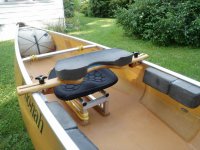Who is Cooper McCrea? I have a grandson named Cooper and have never known anyone else with that name.
Cooper is my younger son. He manages my photo sharing accounts because his father is too stupid to learn how to add photos to albums.
His name is the consequence of having an older brother named Tyler. We narrowed Coopers name criteria down to a two syllable trade or craft name ending in er. My wife did not like Plumber or Welder, Butcher was out because she is vegetarian, and Drywallhanger had too many syllables.
Were I to try to do all that, I would be too exhausted to go canoeing! On my long trips, I certainly saw how handy many of these adaptations would be, but never got around to any of them except knee straps for white water.
Comfort is important to me even on day trips.
I encourage you to add knee bumpers to the Advantage. Given the narrow gunwale width that is likely as simple as a Walmart Yoga Block contact cemented immediately below each inwale where your knees rest, and is a simply an outfitting task as exists.
If you are unsure about that permanent installation just duct tape the yoga blocks in place and try a test paddle.
Yoga blocks would provide a minicel cushion 9 inches long x 6 inches tall, extending out 3 inches on each side for more comfortable knee spread and points of contact.
Sit in the canoe and mark the gunwales for where your knees rest.
Alcohol clean the inside of hull below that mark
Center a yoga block below the inwale on that mark and pencil trace around the perimeter on the hull.
Tape around that pencil marked box on the sides and bottom.
Apply a coat of red can DAP Weldwood contact cement to one side of each yoga block, and inside the taped box on the hull.
Apply a second coat to the yoga block once it dries, ie a surprisingly few minutes later.
Apply a third coat to the yoga block once it again has dried, ie a more few minutes later.
Pull the tape.
OPTIONAL, hit both surfaces, hull and yoga block, with a heat gun or hair drier.
Aiming carefully, press the yoga block to the contact cement rectangle on hull. Adhesion is instantaneous.
OPTIONAL, clamp the yoga blocks to the hull for several hours or a day.
OPTIONAL, run a bead of Amazing Plumbers Goop around the perimeter of the mincel to hull edge the next day. I do not know about goopy Plumbing uses, but that adhesive sealant stuff really is amazing at preventing water, sand and grit infiltration, and edge lift, with contact cemented minicel.
INCREMENTALLY OPTIONAL, carve the knee surface of that minicel down to a custom knee fit. 80 grit or lower sandpaper will do so slowly, a piece of drywall sanding sheet is faster and easier.
Yoga Blocks, 2.97 each
DAP Weldwood contact cement, 5 bucks for a way more than enough 16 oz can.
Disposable 1 inch chip brush, fifty cents.
30 minutes work.
12 bucks.
Increased comfort and control, priceless.
A simple strap yoke from Mohawk, complete with all parts and instructions, will facilitate short carries and requires only a 3 16 inch drill, screwdriver and wrench. A drill two holes simple 30 minute job.
https://www.mohawkcanoes.com/collections/seats-yokes-and-thwarts/products/webbing-yoke
And a DIY Velcro spare paddle shaft keeper. Cut a length of double sided Velcro sized to fit around the paddle shaft, cut another length to wrap over that around the front thwart. Put the shaft Velcro under the thwart Velcro. Done in 60 seconds. Do not run with scissors.
https://www.walmart.com/ip/VELCRO-Brand-VELCRO-Brand-One-Wrap-Reusable-Adhesive-Strap/19535849
And OK I will stop now, before we get into how to install painter keeper bungee on a wee winky Wenonah deck cap.


